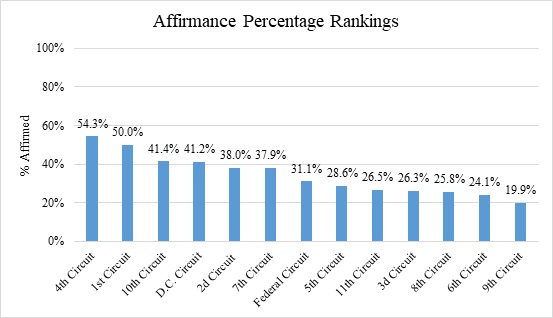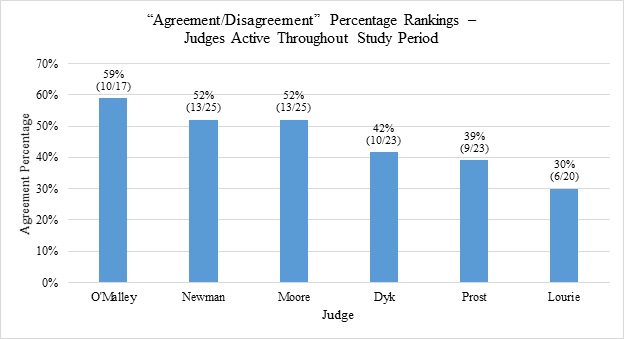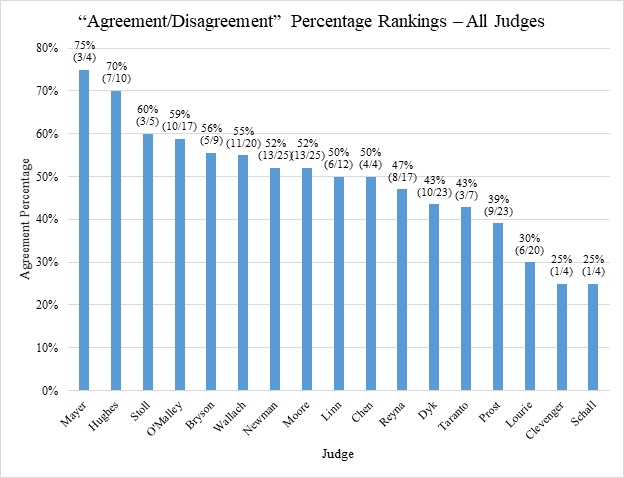How well do Federal Circuit decisions hold up at the Supreme Court? And which Federal Circuit judges have their votes most often affirmed? With the new Supreme Court term around the corner, we dove into a decade's worth of data to find out. The bottom line: the Federal Circuit holds its own at the Supreme Court.
The Federal Circuit in the Supreme Court. The Federal Circuit's relationship with the Supreme Court is unique. Unlike other courts of appeals, the Federal Circuit's jurisdiction is defined exclusively by subject matter, not geography.1 That means the usual rationale for Supreme Court review—resolution of a conflict between circuits—is often absent in cases decided by the Federal Circuit.
Typically operating without the benefit of a circuit split, lawyers seeking review of Federal Circuit decisions frequently emphasize the importance of the issue and the gravity of the court of appeals' supposed error. Such efforts are increasingly successful. As Adam Feldman has shown, the proportion of the Supreme Court's merits docket taken up by Federal Circuit cases has steadily increased since that circuit's creation in 1982.
Given its unique status, does the Federal Circuit fare worse than other circuits at the Supreme Court? After all, if the main rationale for reviewing Federal Circuit decisions is potential error correction (rather than resolution of a circuit split), one might think the reversal rate would be relatively high. But that is not so. In fact, the Federal Circuit's success rate in the Supreme Court is slightly above average.
Since October Term 2010, the Supreme Court affirmed 30.5% of the time when reviewing decisions of the various federal courts of appeals. In the 45 Federal Circuit decisions reviewed during the same period, the Supreme Court affirmed 31.1% of the time.
What if we rank the circuits from most affirmed to most reversed over the same 10-year period? There are 13 circuits, so the median circuit is seventh. Where does the Federal Circuit rank? Seventh. Again, right in the middle of the pack. (Thanks to SCOTUSblog's Stat Pack for these numbers.)

How do the numbers look if we examine only patent cases? The Federal Circuit's jurisdiction is specialized and eclectic—it hears appeals on government contracts, veterans' benefits, takings claims, and other subjects. But the Circuit's patent cases are of intense interest to many technology and life sciences companies, and are of increasing interest to the Supreme Court as well.
Of the 45 Federal Circuit decisions reviewed by the Supreme Court during our study period, 31 were patent cases. How does the Federal Circuit compare to other circuits if we examine results in only those cases? The Supreme Court affirmed 32.3% of the time in the Federal Circuit's patent cases. That's slightly higher than the Federal Circuit's affirmance rate across all cases but would still place it seventh among the circuits.
So what of the perception that the Supreme Court grants review from the Federal Circuit to reverse? The data suggest that, whatever the Supreme Court may intend when it grants, that's not how it plays out—or, at least, no more so than for other courts of appeals.
Federal Circuit Judges in the Supreme Court. We also looked at how the votes of individual judges held up at the Supreme Court.
Quick note on methodology. To make these calculations, we scored each case from the Federal Circuit reviewed by the Supreme Court over the last 10 years as an "agree" or "disagree" for relevant Federal Circuit judges. We scored as "agree": being in the majority of a panel or en banc decision that was affirmed; dissenting from a panel or en banc decision that was reversed; or dissenting from denial of en banc review of a panel decision that was reversed. Mirror image actions were "disagree": being in the majority of a panel or en banc decision that was reversed; dissenting from a panel or en banc decision that was affirmed; or dissenting from denial of en banc review of a panel decision that was affirmed.
In a few cases, we looked past the actual decision under review and assigned "agree" or "disagree" based on the previous Federal Circuit decision that established the precedent binding the subsequent panel. So, for example, last Term in Thryv, Inc. v. Click-to-Call Technologies, LP, the Supreme Court reversed the Federal Circuit and held that the Patent Trial and Appeal Board's IPR time-bar determinations are nonappealable. In assigning judges to the "agree" and "disagree" categories based on that decision, we looked to the Federal Circuit judges' votes in Wi-Fi One, LLC v. Broadcom Corp. (en banc), rather than the decisions under direct review. Those decisions merely adhered to Wi-Fi One's resolution of the relevant issue. In cases like that, it seems more accurate to attach significance to the votes of judges on the precedent-setting panel (or en banc court), not those of the later panel bound to follow the earlier decision.
Finally, these results are subject to significant caveats, which we discuss below.
On to the results. If we restrict the pool of Federal Circuit judges to only those who were active throughout the study period, thus excluding senior judges who sit on fewer cases and judges who joined the court after 2010, the judge with the highest "agree" percentage is Judge O'Malley, at 58.8%. She's followed closely by Judges Newman and Moore, tied at 52%.

If we widen the lens to include both senior judges and judges who joined the court during the study period, we get a new top three (albeit based on a smaller set of cases): Judge Mayer at 75%, Judge Hughes at 70%, and Judge Stoll at 60%.

Caveats. It would be a mistake to read too much into this judge-specific data. Looking only at cases reviewed by the Supreme Court leaves out the vast majority of circuit decisions—those where certiorari was denied or never sought. That means the lion's share of a judge's work is not reflected in our scoring. Also, a judge's practice of noting their views on denial of en banc review also impacts their score. As we discussed in one of our previous posts, Federal Circuit judges vary widely in whether they note such dissents. And judges might believe a panel decision is wrong yet still vote against en banc rehearing because, for example, they think en banc review is not a good use of the Court's institutional resources. But they would not get "credit" in our scoring for agreeing with the Supreme Court if it eventually grants certiorari and reverses. Also, in some cases, the Federal Circuit applies another circuit's precedent in whole or in part, yet our methodology includes such cases in the "agree"/"disagree" tally. E.g., Romag Fasteners, Inc. v. Fossil, Inc., 140 S. Ct. 1492 (2020).
Finally, we intentionally labeled our categories with the nonjudgmental words "agree" and "disagree." Some have argued that the generalist Supreme Court should be more deferential to the Federal Circuit on patent law questions. See, e.g., Rebecca S. Eisenberg, The Supreme Court and the Federal Circuit: Visitation and Custody of Patent Law, 106 Mich. L. Rev. First Impressions 28 (2007). So, at least some of the time, the fact that the Supreme Court disagrees with the views of a Federal Circuit judge with deep expertise in patent law may be an example of Justice Jackson's quip about the Supreme Court: "We are not final because we are infallible, but we are infallible only because we are final."
Footnotes
The D.C. Circuit's jurisdiction is a geographic/subject-matter hybrid—it hears appeals from the District of Columbia and reviews certain agency proceedings.
Because of the generality of this update, the information provided herein may not be applicable in all situations and should not be acted up1 on without specific legal advice based on particular situations.
© Morrison & Foerster LLP. All rights reserved
